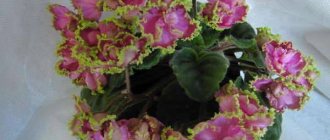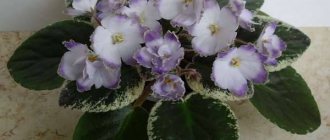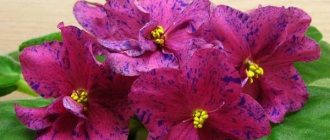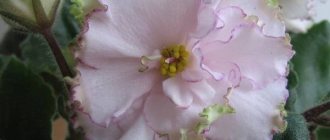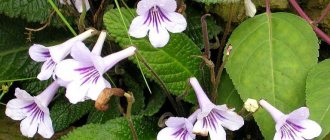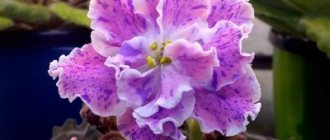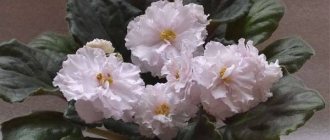Violet Georgia
Those who like double, brightly colored flowers will certainly like the Georgia violet, pictured. This variety, selected by T. Dadoyan, is distinguished by lush, long-lasting flowering. The corollas of a catchy pink hue are decorated with a raspberry-lilac coating and a green corrugated frill along the edge of the wavy petals. These flowers look most impressive against the background of dark green foliage.
Transplanting violets Stone flower
Sometimes violets need to be transplanted into a larger pot. It is better to do this in the spring, when the plant enters the active phase after wintering. Relocation of a flower is carried out by transshipment with a lump of earth, minimally damaging the roots.
[adsp-pro-6]
The new flowerpot should be only a couple of centimeters wider than the previous one. Ideally, its diameter should not exceed a third of the width of the leaf rosette. Fine expanded clay or vermiculite is poured into the pot, leaving a sufficient hole for drainage.
Violet loves slightly acidic soil, loose and light. Specialized stores sell ready-made soil mixture for it. A self-prepared substrate should consist of equal parts of turf and leaf soil, sand and peat with the addition of a small amount of charcoal. Before putting it into the pot, keep it in a well-heated oven for ten minutes and wait until it cools down.
Adult violets of the Stone Flower variety require annual replanting.
Violets Arctic Frost
The Arctic Frost violet variety developed by Sorano has a cap of the most delicate white flowers with a wide, blurred border of a dark blue hue. The corollas are simple or semi-double, extremely showy, large and wavy. The foliage is quilted, dark, oval-ovate in shape.
The Arctic frost violet variety sometimes surprises the grower with the appearance of chimeras that produce spectacular flowers with contrasting white stripes in the middle of each petal.
Possible diseases and pests
If the growing rules are violated, violets may get sick or be attacked by pests due to decreased immunity.
Possible diseases:
- Fusarium - rotting of roots and browning of leaf petioles, which then fall off. Affected plants are treated with fungicides, and their rotten parts are removed. As a preventative measure, they are watered with foundationazole twice a month.
- Powdery mildew appears as a white coating on all parts of the flower. Prevention of the disease is timely wet wiping of the leaves. Sick plants are sprayed with foundationazole or benlate.
- Late blight is a dangerous disease in which the roots rot and brown spots appear on the leaves. Affected plants are destroyed. Superphosphate is added to the soil prophylactically.
- Gray rot appears as a dark coating on the leaves. It spreads quickly. As a preventative measure, the soil is kept in the freezer and treated with a manganese solution. Sick plants are treated with fungicides.
Dangerous pests:
- Spots on violet leaves indicate the presence of disease or pests.
Scale insects hide in the soil and leaf axils. Their appearance is recognized by brown-red spots on the leaves. You can fight them by treating plants with Actellik, Actara or Fittoverm, or by replanting plants.
- Aphids are brought in from cut flowers, small insects suck out the plant juice, while the buds fall off and the flowers wither. Treatment with mospilan or actellik is effective against parasites.
- Mites (red, spider and cyclamen) - deform leaves, leave cobwebs and spots of different colors, and prevent flowering. Plants are wiped with soapy water or sprayed with the same preparations used for insect infestations.
Violet Esmeralda
The Esmeral variety is in the collection of two breeders. The Esmeralda violet, bred by E. Lebetskaya, produces large, fuchsia or ripe raspberry colored terry corollas. The flowering is abundant and lush; the head of flowers looks especially advantageous on the even green rosette formed by this variety.
The Esmeralda violet shown in the second photo was created thanks to the work of S. Repkina. This variety produces voluminous double flowers with a diameter of up to 7 cm. The color of the corollas is thick cherry, “delicious”. The edges of each wavy petal are edged with white edging; the center of the corolla has a more saturated color in tone. The foliage is evenly colored in a pleasant dark color.
Conditions of care and maintenance
An amateur cannot grow a “Stone Flower”. It grows slowly and requires careful care to stimulate flowering.
Temperature
This plant is quite thermophilic, feels comfortable at 20-24 degrees, and blooms for a long time in such conditions. Winter temperatures should not fall below 16 degrees. At this time, it is better to remove the violet from the windowsill to a shelf where it is warm and light. At low temperatures, the leaves become stained, and if they freeze for a long time, the plants die.
The heat also does not benefit the plants; their leaves turn yellow and fall off. In such conditions, they often drop buds and flower stalks.
Air humidity
It is necessary to maintain humidity at 50-60%.
The optimal humidity for a flower is 50-60%. To increase it, it is useful to spray the plant with filtered warm water from a spray bottle, avoiding the droplets getting on the flowers and buds.
It is important to periodically wipe the fleecy leaves with a damp cloth, and in the heat, give the flower a shower by covering the ground with film. A container of water placed next to the heater helps cope with dry air when radiators are running in winter.
The stone flower loves a humid and warm atmosphere, in such conditions it blooms in larger colors.
Violet placement Stone flower and lighting
Violet feels comfortable on the western or eastern side. On a southern windowsill it needs to be shaded from direct sun, but on a northern one it lacks light, especially in winter.
Violet prefers diffused light; direct sunlight burns it. A plant that is too shaded may have leaves that rot. And if they are overly moistened, then you can be wary of fungal diseases and spider mites.
[adsp-pro-5]
In a dark room, the plant needs lighting. In order for it to bloom regularly, you need to artificially increase the duration of daylight hours to 12 hours.
Important! The flower needs to be turned periodically so that the light does not constantly fall on one side. Otherwise, it will become one-sided and unevenly developing.
Organization of watering
Improper watering destroys the plant and it rots. Spots appear on the petals, the inflorescences dry out, the leaves turn yellow and disappear, and the roots rot. Let's water with settled warm water. Watering schedule: in summer - 2 times a week, and in winter 2-3 times less often and only when the soil dries a couple of centimeters deep.
It is very important to properly organize watering of violets of the Stone Flower variety.
Proper watering methods:
- Pour plenty of water into the pan of the pot. The remaining liquid should be drained after a couple of hours.
- Top watering. To do this, use a bottle or watering can with a narrow neck, watering along the edge of the flowerpot so that the top soil layer is not washed away. It is unacceptable for drops to get on young leaves and flowers. Watering stops after water begins to pour out of the pot into the pan through the drainage hole. All excess must be drained.
- Bottom watering. In this case, the “wet lace” method is used. When planting a flower, a rope made of natural material is inserted into the drainage hole. The flowerpot is placed in a container of water so that its bottom does not reach the surface. The end of the cord is lowered into the water. Moisture enters the flowerpot with violets using the capillary method. This type of watering is useful if the water is hard and contains a lot of harmful salts. In case of absence of the owners, this method can provide watering of flowers for 2-3 weeks.
Organization of feeding
During active growth and flowering, the plant needs to be fertilized with universal fertilizer for violets. You can use, for example, Gumi humisol, diluting it twice as much as indicated in the instructions, and fertilize the flowers 1-2 times a month, combined with watering.
To feed violets, you can use universal fertilizers.
It is good to use improvised means for fertilizing:
- Tea brew in threefold dilution.
- Coffee grounds – they increase the acidity of the soil. The product is mixed with soil and the flower is not watered for some time.
- Citrus peels, steeping them in boiling water for 24 hours and then diluting them ten times.
- Sprinkling with a fresh decoction of onion peels.
Carefully! You cannot feed violets for a month after transplantation.
Breeder K. Morev
A programmer by profession, he has been developing new varieties for quite some time - since 1994. Morev studied with Boris Makuni himself and is perhaps the master’s most talented student. When meeting a breeder, everyone notes his main character traits as modesty and charm. Morev was engaged in floriculture from a very young age. It so happened that, by the will of fate, he lived in the same building as Boris Makuni, and this largely predetermined his passion for violet selection.
Our experts have prepared for you articles about other types and varieties of violets with the names of the people who raised them, namely the breeders:
- Natalia Skornyakova;
- Makuni spouses;
- Tatyana Pugacheva;
- Elena Korshunova;
- Natalia Puminova;
- Evgeniy Arkhipov;
- Svetlana Repkina;
- Elena Lebetskaya.
Reviews from flower growers about the variety
Flower growers note that with age, violets bloom more brightly.
Elena Mikulinich. Such beautiful and majestic flowers that they take your breath away! I can't stop looking at it.
Tamara Bobina. The flowers are medium in size and require patient care. The first flowering was with a white ruffle without greenery, it took place in the heat at the end of summer. In late autumn I admired it in all its glory.
Margarita Solovyova. My Stone Flower begins to bloom in the spring with a lush head of flower stalks. At first there were fewer of them and they were paler, but the older the violet, the richer the color.

